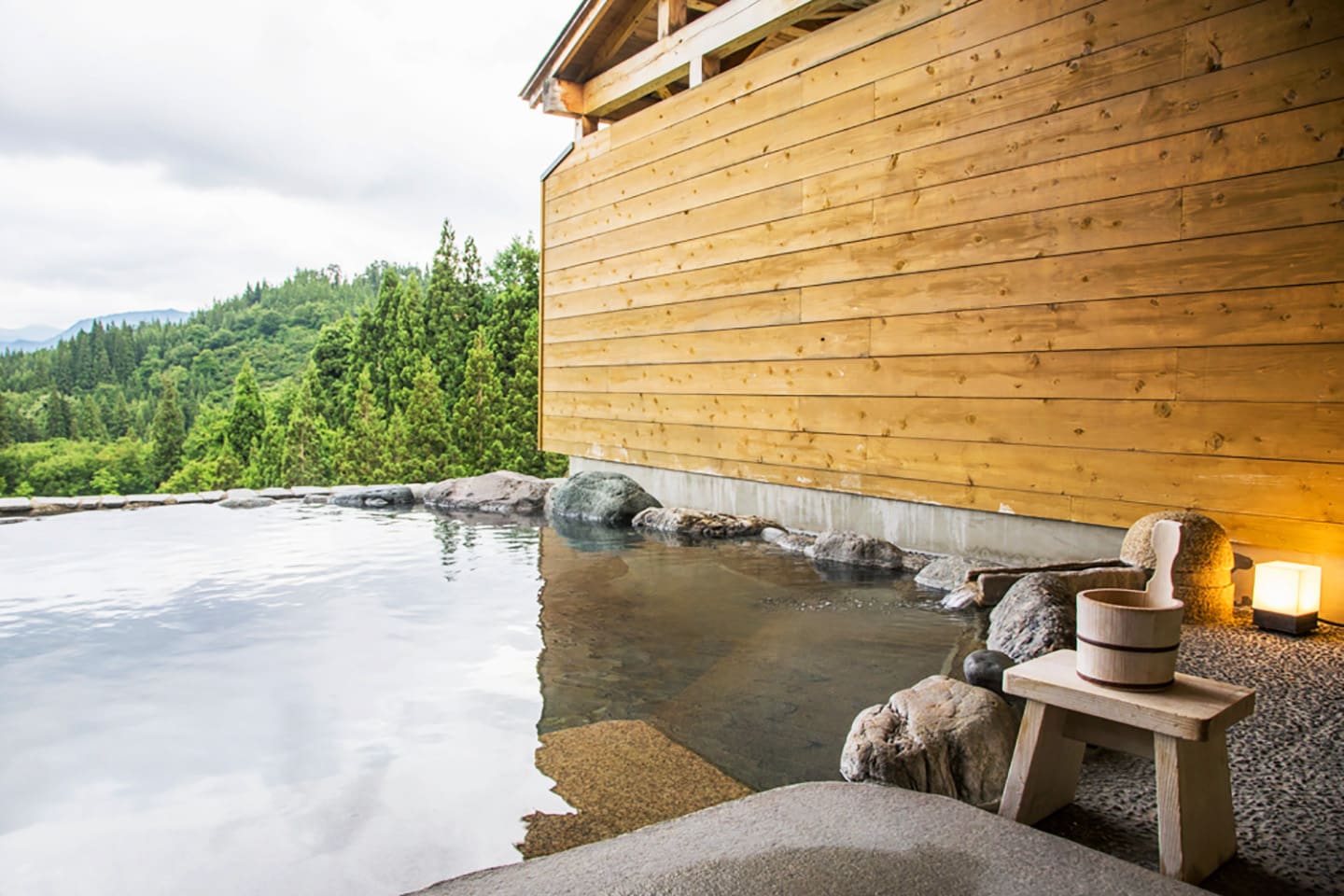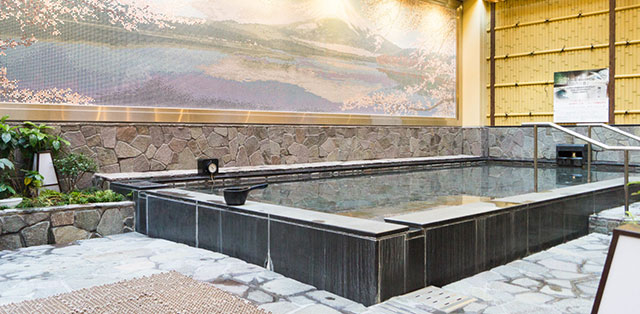
Japan is one of the world's number one hot spring countries and there are more than 27,000 hot springs in Japan, gushing out 2.6 million liters of hot spring water every minute. With such abundant resources due to geothermal activity in nearly every region, visiting onsen is by far popular list on the itinerary. Here is a guide and manners to consider when visiting the onsen.
-
01
Onsen & Sento: Differences
![]()
In short, onsen is a natural hot spring bath while sento is an indoor public bath with ordinary heated water. In detail, onsen is a water which is geothermally heated beneath the ground and rises to the surface bubbling hot. According to the Hot Spring Act which was set in 1948 and revised in 2011,the prerequisites of an official onsen are that the water must contain at least one of the 19 designated chemical elements that naturally occur in hot spring water, and it must be at least 25℃ when it comes out of the ground. As long as the water contains lithium or hydrogen ions, even if the temperature is cold, that water is considered as a hot spring. On the other hand, sento is looked on as the everyday bathhouses of ordinary Japanese people. And according to the Public Bathhouses Act, the entry fee for sento must be the same everywhere within that same prefecture. Although there are some differences between different regions and prefectures, the average price would be somewhere around 500yen.
READ MORE- Visiting a Sento
-
![]()
- Public Baths
-
02
Types of Onsen
Simple Spring (単純温泉)
Even when the water is over 25℃, the components in this type of hot spring will not reach a defined amount. Therefore, it doesn’t stimulate the body so even children and the elderly can enjoy it. It is considered effective for recovery from fatigue, nerve pain, insomnia, hardening of the arteries, high blood pressure, etc. If the level of pH is 8.5 or higher, the spring is classified as the “alkaline simple spring” and is famous for making the skin smooth as you soak up in the spring. This type is popular among women.
Simple Carbon Dioxide Spring (二酸化炭素泉)
It is as if you are taking a bath inside a fizzy carbonated drink, there are air bubbles that adhere to the body which expands the blood vessels to lower blood pressure. If the temperature is too high, the fizziness will go flat so typically, compared to other types of hot spring, this simple carbon dioxide spring is set to a lower temperature. It is considered effective for paralysis, muscle/joint pain, contusions, high blood pressure, hardening of the arteries, cuts, sensitivity to cold, menopausal disorders, infertility, etc.
Chloride Spring (Salt Spring) (塩化物泉)
Something similar to the seawater, this type of spring contains high levels of salt.It can be subcategorized into sodium-chloride spring, calcium-chloride spring and magnesium-chloride spring, depending on the components other than salt. The salt on the skin from taking this bath has an effect on reducing the evaporation of perspiration and keeps the skin moisturized for a long time after bathing. It is considered effective for muscle/joint pain, contusions, sprains, sensitivity to cold, chronic women's diseases, infertility, etc.
Sulfate Spring (硫酸塩泉)
Hot springs with a high content of sulfuric acid are called sulfate springs. There are three types, calcium sulphate, sodium sulphate, and magnesium sulphate springs. Because of the certainty of its efficacy, these three types of springs have been valued since the ancient times. It is considered effective for rheumatism, bruises, cuts, burns, etc. for calcium sulfate, for sodium sulfate, high blood pressure, hardening of the arteries, external wounds, etc. and lastly for magnesium sulfate, rheumatism, bruises, cuts, burns, high blood pressure, hardening of the arteries, external wounds, etc
Ferruginous Spring(Irong spring) (含鉄泉)
A ferruginous spring contains a large amount of iron and there are two types: those that contain iron carbonate, and those that contain melanterite. The color of the spring is red, yellow or reddish-brown to the water oxidizing when exposed to air. Soaking up in this spring will retain heat and keep you warm. The rusty smell of the iron is also the characteristic of this spring. It is considered effective for anemia, rheumatism, menopausal disorders, hypoplastic uterus, chronic eczema, etc.
Sulphur Spring (硫黄泉)
This type of onsen is known for its characteristic odor of hydrogen sulphide, and causes the blood vessels to expand. However, poor ventilation can be dangerous and should be avoided. The color of the water is often cloudy white or yellowish brown from the sulfur contacting the air and oxidizing. It is considered effective for high blood pressure, hardening of the arteries, chronic skin diseases, joint pain, etc.
Acidic Spring (酸性泉)
An acidic spring contains a lot of hydrogen and is characterized by its low acidity. Those with a pH between 2 and 4 are called acidic springs, while those with a pH below 2 are called highly acidic springs. These springs are more stimulating than any other types of hot springs, and these strong acidities can cause a tingling sensation on the skin. People with delicate skin, elderly and small children should avoid taking a bath this spring. And those who took a bath in this spring should take a shower to rinse off any acids on your body. Then moisturize the skin with any lotion afterwards. It is considered effective for chronic skin diseases, chronic women's diseases, diabetes, athlete's foot, etc.
Radioactive Spring (放射能泉)
A radioactive spring may sound scary to some people, but the amount of radiation contained in a radioactive spring is much lower than the amount of radiation you are exposed to when you take an X-ray. This spring contains a small amount of radioactive substances, but mainly radon. Radiation is absorbed by the skin and respiratory organs but there's no need to worry since it leaves your body immediately after bathing. It is considered effective for high blood pressure, hardening of the arteries, nerve pain, rheumatism, calming stress, gout, etc.
Carbonated Spring (炭酸水素塩泉)
Alkaline hot springs are said to emulsify sebum through a chemical reaction to cleanse the skin. Because of its effect of removing excess oil from the skin and promoting metabolism, carbonated springs have become synonymous with the "hot water of beauty". When the sebum is cleaned off, the water on the surface of the skin evaporates, leaving you with a pleasantly cool and refreshing sensation after the bath.There are two types to this spring, bicarbonate earth springs, which have alkaline properties, and sodium bicarbonate springs. It is considered effective for muscle/joint pain, contusions, cuts, chronic skin diseases, etc. -
03
The Rules
①Go naked, not even speedos!
Unsurprisingly, this is the bit that puts most people off. However, it is the Japanese traditional culture that people take onsen without any clothing. If stripping off in public is too distracting for you, then booking a guest room with private onsen is the best option. In some ryokan (traditional Japanese inns) have a room with your own private onsen however, the water may be just regular hot water so if you want a real “onsen”, contacting the ryokan prior to your booking is highly recommended.
②Shower well before you bathe
Japanese people always clean themselves under the shower before having a soak in the bath and this is even more important when you’re visiting a communal sento or onsen to keep the water as clean as possible. In most onsen, soap, shampoo and conditioner are usually provided, though you can bring your own if you prefer. You must sit down while you wash to avoid splashing others. Don’t forget to thoroughly rinse off any soaps to also avoid the natural onsen getting dirty.
③No running, no swimming
As the floor is quite slippery, make sure to walk instead of running to avoid any injuries. Although the bathtub for onsen may seem intriguing to swim, however, it is forbidden to swim. Onsen is for relaxing, not for exercising.
④Hair & head
If you have long hair, always remember to bring a hairband or to wrap your hair in a small towel, as even if you’ve just washed your hair under the shower.⑤Towel
At most onsen, you will either be provided with a small and a large towel. The large towl is for drying yourself while the small towel is for washing and can be taken into the bathing area. Usually, you will encounter many putting the towel or tenugui (Japanese thin hand towel) on the head while enjoying soaking yourself in the hot spring. Do not soak and wash the towel in the hot spring![]()
⑥Tattoo
Most of the onsen ban people with tattoss but there are exceptions. Take a look at the following article fore more details.READ MORE- Visiting Japan with Tattoos: Manners/Etiquette
-
![]()
- Need to Know
-
04
Where to go for onsen?
Japan is the land of hot springs and there are many different types dispersed all around the country. These hot springs have been lauded for centuries for their health benefits and also for their rejuvenating effect on the mind and spirit due to the beauty of their locations. Here are some guide to help you plan your onsen trip in Japan.
READ MORE- Hidden Onsen in Japan: Discover Japan’s Best Secret Hot Springs
-
![]()
- Hot Springs
- Beppu Jigoku Meguri (Hot Springs Tour)
-
4.0
1666 Reviews -
-
- Oita Pref. Beppushi Kannawa 559-1
-
-
-
- 0977661577
-
-
-
- 8:00-17:00
-
View All






 Go here
Go here





